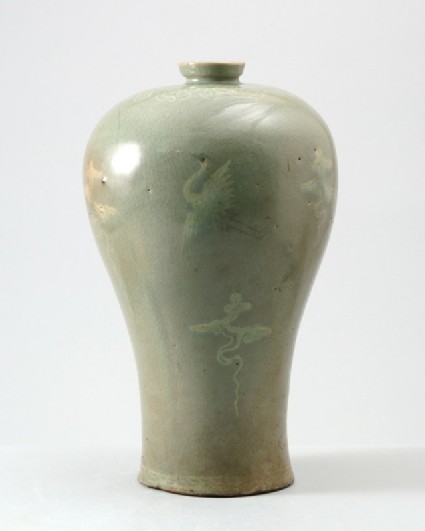Browse: 230 objects
Greenware maebyong, or plum blossom, vase with cranes
- loan
-
Details
- Associated place
- Date
-
12th century (1101 - 1200)
Koryo Dynasty (AD 935 - 1392)
- Material and technique
- stoneware, thrown, with inlaid slip decoration under a green glaze; gold lacquer repair; unglazed base; glazed rim
- Dimensions
-
31.5 cm (height)
18.3 cm (diameter)
at base 11.7 cm (diameter)
- Material index
-
processed material › metal › gold,
- Technique index
- Object type index
- No. of items
- 1
- Credit line
- Lent by the Sir Alan Barlow Collection Trust.
- Accession no.
- LI1301.158
-
Further reading
University of Sussex, and Arts and Humanities Research Council, The Barlow Collection, supervised by Regina Krahl, Maurice Howard, and Aiden Leeves (Sussex: University of Sussex, 2006), no. C135
Glossary (4)
glaze, lacquer, slip, stoneware
-
glaze
Vitreous coating applied to the surface of a ceramic to make it impermeable or for decorative effect.
-
lacquer
Chinese and Japanese lacquer is made from the sap of the lacquer tree, which is indigenous to Eastern China. It is applied to wood as a varnish or for decorative effect. In India and the Middle East, lacquer is made from the deposit of the lac insect.
-
slip
A semi-fluid clay applied to a ceramic before glazing either to coat the surface or for decorative effect.
-
stoneware
Ceramic material made of clay which is fired to a temperature of c.1200-1300⁰c and is often buff or grey in colour.
Location
-
- currently in research collection
Objects are sometimes moved to a different location. Our object location data is usually updated on a monthly basis. Contact the Jameel Study Centre if you are planning to visit the museum to see a particular object on display, or would like to arrange an appointment to see an object in our reserve collections.
Publications online
-

The Barlow Collection
The vase has a wide bulging shoulder and tapers to a slender body, which widens again very slightly at the base, resting on a broad shallow footring. The narrow mouth has an everted angular rim. The shoulder is inlaid in white slip with a band of pendant overlapping ruyi-like petals, the body with three white cranes in flight, with beaks, crests and legs inlaid in contrasting black, surrounded by six white cloud motifs, with a white slanting key-fret border at the base. The light green glaze is crackled and has shrivelled on the base, and leaves the footring exposed in the brown-burnt biscuit. A long gilt repair is probably hiding a firing crack.
© 2013 University of Oxford - Ashmolean Museum





